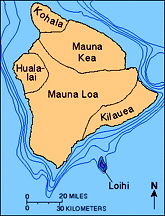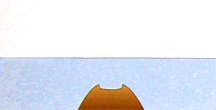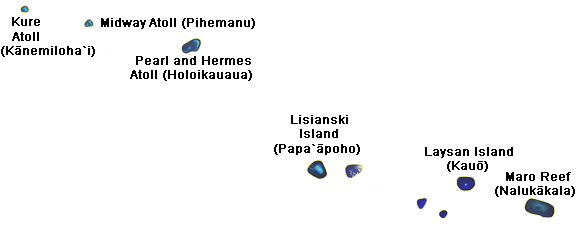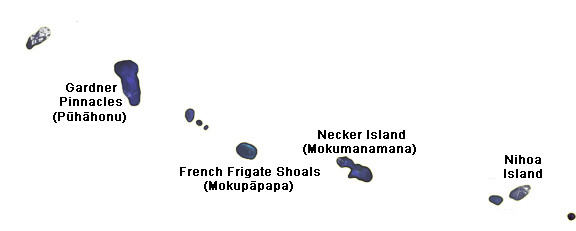Puke Palapala `Āina (Atlas)
|
“Never was so much landscape gathered together in one place. The diversification is endless, from the lava shores of South Puna to the barking sands of Kauai. On every island breakneck mountain climbing abounds. One can shiver above timber line on the snowcaps of Mauna Kea or Mauna Loa, swelter under the banyan at sleepy old Lahaina, swim in clear ocean water that effervesces like champagne on ten thousand beaches, or sleep, under blankets every night in the upland pastures and awaken each morning to the song of skylarks and the crisp, snappy air of spring.” Jack London |
|||||||||
|
Hawai`i is the longest
state in the US: stretching over 1,523 miles (2,451km) and still
growing. Number 2, Alaska, is 1,479 miles long (2,380 km), north to south, and
California, is only 770 miles long (1,239km). Hawai`i is the southernmost state in the US: on the same latitude (19.00.07n) as Veracruz, Mexico, the Cayman Islands, the Sahara Desert, and Bombay, India Hawai`i is home to the tallest mountain on earth: Mauna Kea, on Hawai`i Island, is 33,465 (10,203m) feet tall from sea floor to summit, 13,796 feet (4,205m) above sea level. Mount Everest is the highest mountain on earth at 29,029 feet (8,848m) above sea level. And home to the largest mountain on earth: Mauna Loa, on Hawai`i Island, has an estimated volume of 18,000 cubic miles (74,000 cubic km). |
|||||||||
|
Pele's Creation
Pele's current home is on Hawai`i Island, where she continues to create new land with Mauna Loa, Kīlauea and Lō`ihi volcanoes. |
|||||||||
|
Hawaiian Aarchipelago |
|||||||||
 |
|||||||||
|
Age Progression of Hawaiian
Islands |
|||||||||
 |
|||||||||
| The Northwestern Hawaiian Islands, Papahānaumokuākea, includes more than 120 islands, atolls and reefs, starting from Nihoa Island in the south to Kure Atoll in the north, 1,200 miles away. This entire coral reef ecosystem is now a protected Marine National Monument. Click on name or island for more information. | |||||||||
|
The Northern Half: |
|||||||||
|
|
|||||||||
|
The Southern Half: |
|||||||||
|
|
|||||||||
| The Eight Major Hawaiian Islands | |||||||||
|
|
|||||||||
The youngest Hawaiian volcano
– Lō`ihi 19 miles (34 km) southeast of Hawai`i
Island, the newest Hawaiian volcano is taking shape. There, Lō`ihi
joins Mauna Loa and Kīlauea
as one of Hawai`i's three active volcanoes. 19 miles (34 km) southeast of Hawai`i
Island, the newest Hawaiian volcano is taking shape. There, Lō`ihi
joins Mauna Loa and Kīlauea
as one of Hawai`i's three active volcanoes.Lō`ihi seamount rises 10,000 feet (3,000 m) from the bottom of the sea, yet its summit still lies 3,200 feet (975 m) below sea level. The summit currently has three craters. The largest, formed in 1996, is called Pele's Pit and is 660 feet (200 m) deep. Scientist do not expect Lō`ihi to reach the surface for tens of thousands more years. |
|||||||||
|
Canoe Plants of Ancient Hawai`i French Frigate Shoals Page Hawai`i and Its Volcanoes Hawaiian Native Plant Genera Hi-Res NOAA Map1 Hi-Res NOAA Map2 |
Kīlauea
Photo Archives Natural History of Hawai`i Northwest Hawaiian Islands Papahānaumokuākea National Monument Pu`u `O`o–Kupaianaha Eruption The Climate Is Simply Delicious Tsunamis, The Big Waves |
||||||||
|
|
|
|
|
|
||
| History | Atlas | Culture | Language | Links |
 Eventually,
erosion returns her islands to the sea, first as coral-capped atolls,
reefs and, ultimately, as seamounts hidden below the surface.
Eventually,
erosion returns her islands to the sea, first as coral-capped atolls,
reefs and, ultimately, as seamounts hidden below the surface.

